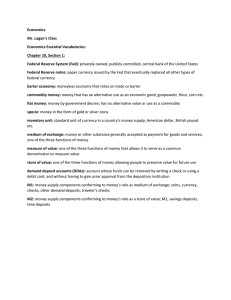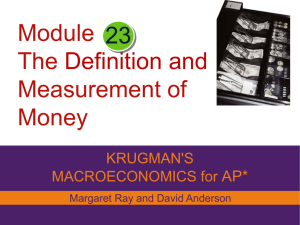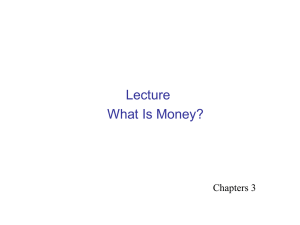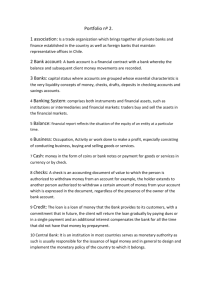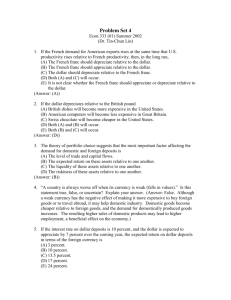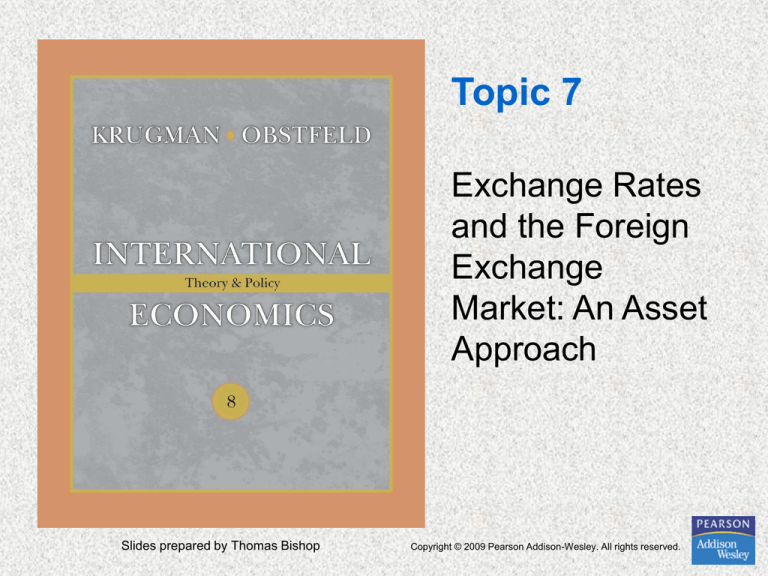
Topic 7
Exchange Rates
and the Foreign
Exchange
Market: An Asset
Approach
Slides prepared by Thomas Bishop
Copyright © 2009 Pearson Addison-Wesley. All rights reserved.
Preview
• The basics of exchange rates
• Exchange rates and the prices of goods
• The foreign exchange market
• The demand for foreign currency deposits
• Equilibrium in the foreign exchange market
role of interest rates
role of expectations of future exchange rates
Copyright © 2009 Pearson Addison-Wesley. All rights reserved.
13-2
Introduction
• The price of one currency in terms of another is called
an exchange rate.
• Because of their strong influence on the current
account and other macroeconomic variables,
exchange rates are among the most important prices
in an open economy.
• An exchange rate is also an asset price, so the
principles governing the behavior of other asset prices
also govern the behavior of exchange rates.
Copyright © 2009 Pearson Addison-Wesley. All rights reserved.
13-3
Definitions of Exchange Rates
• Exchange rates are quoted as foreign currency per
unit of domestic currency or domestic currency per
unit of foreign currency.
How much can be exchanged for one dollar? ¥102/$1
How much can be exchanged for one yen? $0.0098/¥1
• Exchange rates allow us to denominate the cost or
price of a good or service in a common currency.
How much does a Honda cost? ¥3,000,000
Or, ¥3,000,000 x $0.0098/¥1 = $29,400
Copyright © 2009 Pearson Addison-Wesley. All rights reserved.
13-4
Table 1:
Exchange Rate
Quotations
Exchange rates are reported
daily in newspapers’ financial
sections.
This shows the dollar
exchange rates for
currencies traded in NY at
4:00 p.m. on July 23, 2007.
Rates listed here are
interbank rates: the rates
banks charge to each other.
No amount less than $1
million is traded at these
“wholesale” rates.
Copyright © 2009 Pearson Addison-Wesley. All rights reserved.
13-5
Depreciation and Appreciation
• Depreciation is a decrease in the value of a
currency relative to another currency.
A depreciated currency is less valuable (less
expensive) and therefore can be exchanged for
(can buy) a smaller amount of foreign currency.
$1/€1 → $1.20/€1 means that the dollar has
depreciated relative to the euro. It now takes $1.20
to buy one euro, so that the dollar is less valuable.
The euro has appreciated relative to the dollar:
it is now more valuable.
Copyright © 2009 Pearson Addison-Wesley. All rights reserved.
13-6
Depreciation and Appreciation (cont.)
• Appreciation is an increase in the value of a
currency relative to another currency.
An appreciated currency is more valuable (more
expensive) and therefore can be exchanged for
(can buy) a larger amount of foreign currency.
$1/€1 → $0.90/€1 means that the dollar has
appreciated relative to the euro. It now takes
only $0.90 to buy one euro, so that the dollar is
more valuable.
The euro has depreciated relative to the dollar:
it is now less valuable.
Copyright © 2009 Pearson Addison-Wesley. All rights reserved.
13-7
Depreciation and Appreciation (cont.)
• A depreciated currency is less valuable, and therefore
it can buy fewer foreign produced goods that are
denominated in foreign currency.
How much does a Honda cost? ¥3,000,000
¥3,000,000 x $0.0098/¥1 = $29,400
¥3,000,000 x $0.0106/¥1 = $31,800
• A depreciated currency means that imports are more
expensive and domestically produced goods and
exports are less expensive.
• A depreciated currency lowers the price of exports
relative to the price of imports.
Copyright © 2009 Pearson Addison-Wesley. All rights reserved.
13-8
Depreciation and Appreciation (cont.)
• An appreciated currency is more valuable, and
therefore it can buy more foreign produced goods that
are denominated in foreign currency.
How much does a Honda cost? ¥3,000,000
¥3,000,000 x $0.0098/¥1 = $29,400
¥3,000,000 x $0.0090/¥1 = $27,000
• An appreciated currency means that imports are less
expensive and domestically produced goods and
exports are more expensive.
• An appreciated currency raises the price of exports
relative to the price of imports.
Copyright © 2009 Pearson Addison-Wesley. All rights reserved.
13-9
Foreign Exchange Markets
• Exchange rates are determined by the
interaction of individuals, firms, and financial
institutions that buy and sell foreign currencies
to make international payments.
• The market in which international currency
trades take place is called the foreign
exchange market.
Copyright © 2009 Pearson Addison-Wesley. All rights reserved.
13-10
Foreign Exchange Markets (cont.)
Major participants:
1. Commercial banks and other depository
institutions
•
Vast majority of foreign exchange transactions
involve the exchange of bank deposits
denominated in different currencies.
•
Banks routinely enter the foreign exchange market to
meet the needs of their customers –primarily
corporations.
Copyright © 2009 Pearson Addison-Wesley. All rights reserved.
13-11
Foreign Exchange Markets (cont.)
2. Non-bank financial institutions (mutual
funds, hedge funds, securities firms,
insurance companies, pension funds)
•
Buy and sell foreign currencies for investment.
3. Corporations
•
Conduct foreign currency transactions to buy/sell
goods, services, and assets.
Copyright © 2009 Pearson Addison-Wesley. All rights reserved.
13-12
Foreign Exchange Markets (cont.)
4. Central banks
•
Conduct official international reserves
transactions.
•
Volume of these transactions are not typically large but
may have strong impacts on exchange rates.
•
Market participants watch central bank actions for clues
about future macroeconomic policies that may impact
exchange rates.
Copyright © 2009 Pearson Addison-Wesley. All rights reserved.
13-13
Foreign Exchange Markets (cont.)
• Foreign exchange trading takes place in many
financial centers, with the largest volume of
trade occurring in:
London, New York, Tokyo, Frankfurt, and
Singapore
• The daily volume of foreign exchange
transactions was $3.2 trillion in April 2007.
About 86% of transactions involved US dollars.
About 37% of transactions involved euros.
Copyright © 2009 Pearson Addison-Wesley. All rights reserved.
13-14
Foreign Exchange Markets (cont.)
• Computer and telecommunications
technology transmit information rapidly so the
foreign exchange market is highly integrated.
• The integration of financial centers implies
that there is no significant arbitrage between
markets.
Arbitrage: buying at a low price and selling at a
high price for a profit.
• What will happen if dollars are cheaper in New York than
in Hong Kong?
• People will buy dollars in New York and sell them in Hong
Kong, so that their price rises in New York and falls in
Hong Kong, until the price of dollars is equal in both
markets.
Copyright © 2009 Pearson Addison-Wesley. All rights reserved.
13-15
Foreign Exchange Markets (cont.)
• Most transactions between banks (86% in 2007) are
exchanges of foreign currencies for U.S. dollars.
• U.S. dollar is sometimes called a vehicle currency
because of its pivotal role in so many foreign
exchange deals.
A vehicle currency is one that is widely used to denominate
international contracts made by parties who do not reside in
the country that issues the vehicle currency.
• Why is the U.S. dollar so prominent?
U.S. is the largest economy in the world with 30% of total
output.
Easy to find buyers and sellers for U.S. dollars.
Copyright © 2009 Pearson Addison-Wesley. All rights reserved.
13-16
Spot Rates and Forward Rates
• Spot rates are exchange rates for currency
exchanges “on the spot,” or when trading is
executed in the present.
• Forward rates are exchange rates for
currency exchanges that will occur at a future
(“forward”) date.
Forward dates are typically 30, 90, 180, or 360
days in the future.
Rates are negotiated between two parties in the
present, but the exchange occurs in the future.
Copyright © 2009 Pearson Addison-Wesley. All rights reserved.
13-17
Fig. 1: Dollar/Pound Spot and Forward
Exchange Rates, 1981–2007
Source: Datastream. Rates shown are 90-day forward exchange rates and spot exchange rates, at end of month.
Spot and forward exchange rates tend to move in a highly
correlated fashion.
Spot Rates and Forward Rates (cont.)
• Forward rates are used to eliminate short-run
exchange rate risk.
• E.g., Radio Shack must pay ¥9,000 for each
Japanese radio in 30 days.
• Each radio can sell for $100, so profits depend on the
dollar cost of the radios.
Current spot rate: $0.0105/¥ → cost per radio = $0.0105/¥ x
¥9,000 = $94.50 → profit = $100 - $94.50 = $5.50.
If $ depreciates: $0.0115/¥ → cost per radio = $0.0115/¥ x
¥9,000 = $103.50 → loss = $100 - $103.50 = -$3.50.
Copyright © 2009 Pearson Addison-Wesley. All rights reserved.
13-19
Spot Rates and Forward Rates (cont.)
• To avoid this risk, Radio Shack can make a 30-day
forward exchange deal with B of A.
B of A sells yen to Radio Shack in 30 days at a rate of
$0.0107/¥.
• Thus, Radio Shack is guaranteed the cost per radio =
$0.0107/¥ x ¥9,000 = $96.30 and profit = $3.70.
Copyright © 2009 Pearson Addison-Wesley. All rights reserved.
13-20
Other Methods of Currency Exchange
• Foreign exchange swaps: a combination of
a spot sale with a forward repurchase.
Swaps often result in lower fees or transactions
costs because they combine two transactions.
• E.g., Toyota has just received $1 million from U.S. sales
and knows it must pay those dollars to a MI supplier in 3
months. Toyota would also like to invest the $1 million in
euro bonds.
• A 3 month swap of dollars into euros avoids the fees from
two separate transactions: (1) selling dollars for spot
euros and (2) selling the euros for dollars on the forward
market.
Copyright © 2009 Pearson Addison-Wesley. All rights reserved.
13-21
Other Methods of Currency Exchange
(cont.)
• Futures contracts: a contract that a specified
amount of foreign currency will be delivered
on a specified date in the future.
Contracts can be bought and sold in organized
futures market, and only the current owner is
obliged to fulfill the contract.
Copyright © 2009 Pearson Addison-Wesley. All rights reserved.
13-22
Other Methods of Currency Exchange
(cont.)
• Options contracts: gives its owner the right
to buy or sell a specified amount of foreign
currency at a specified price at any time up to
a specified expiration date.
Option’s seller is required to sell or buy the foreign
currency at the discretion of the option’s owner,
who is under no obligation to exercise his right.
Such contracts are helpful if you are uncertain
about the timing of foreign currency payments.
Copyright © 2009 Pearson Addison-Wesley. All rights reserved.
13-23
Other Methods of Currency Exchange
(cont.)
• Forwards, swaps, futures, and options are all
examples of financial derivatives –which are
recorded in a country’s financial account.
Financial derivatives are a class of assets that are
more complicated than stocks and bonds, but with
values that can depend on stock or bond values.
In 2006, the net cross-border derivative flow into
the U.S. was $28.8 billion.
Copyright © 2009 Pearson Addison-Wesley. All rights reserved.
13-24
The Demand for Currency Deposits
• What influences the demand for (willingness
to buy) deposits denominated in domestic or
foreign currency?
• Demand for bank deposits is influenced by the
same factors that influence the demand for
any other asset.
Namely, what is the expected real rate of return?
Copyright © 2009 Pearson Addison-Wesley. All rights reserved.
13-25
The Demand for Currency Deposits (cont.)
• Rate of return: the percentage change in
value that an asset offers over some time
period.
The annual return for $100 savings deposit with an
interest rate of 2% is $100 x 1.02 = $102, so that
the rate of return = ($102 - $100)/$100 = 2%.
Copyright © 2009 Pearson Addison-Wesley. All rights reserved.
13-26
The Demand for Currency Deposits (cont.)
• Real rate of return: inflation-adjusted rate of
return,
represents the additional amount of goods and
services that can be purchased with earnings from
the asset.
The real rate of return for the above savings
deposit when inflation is 1.5% is: 2% – 1.5% =
0.5%. After accounting for the rise in the prices of
goods and services, the asset can purchase 0.5%
more goods and services after 1 year.
• If the inflation rate is 0% then (nominal) rates of return
= real rates of return.
Copyright © 2009 Pearson Addison-Wesley. All rights reserved.
13-27
The Demand for Currency Deposits (cont.)
• Risk of holding assets also influences
decisions about whether to buy them.
• Liquidity of an asset, or ease of using the
asset to buy goods and services, also
influences the willingness to buy assets.
• For now, we assume that all bank deposits
have the same level of risk and liquidity,
regardless of their currency denomination.
Copyright © 2009 Pearson Addison-Wesley. All rights reserved.
13-28
The Demand for Currency Deposits (cont.)
• We therefore say that investors are primarily
concerned about the rates of return on
currency deposits.
• Rates of return that investors expect to earn
are determined by:
interest rates that the deposits earn
expectations about the currency’s appreciation or
depreciation against other currencies
Copyright © 2009 Pearson Addison-Wesley. All rights reserved.
13-29
The Demand for Currency Deposits (cont.)
• A currency deposit’s interest rate is the amount of
that currency an individual can earn by lending a unit
of the currency for one year.
• The rate of return for a deposit in domestic currency
is the interest rate that the deposit earns.
• To compare the rate of return on a deposit in domestic
currency with one in foreign currency, consider
the interest rate for the foreign currency deposit
the expected rate of appreciation or depreciation of the
foreign currency relative to the domestic currency
Copyright © 2009 Pearson Addison-Wesley. All rights reserved.
13-30
The Demand for Currency Deposits (cont.)
• Suppose the interest rate on a dollar deposit is 10%
and the interest rate on a euro deposit is 5%.
• Suppose today’s exchange rate is $1.10/€, and the
expected rate in one year is $1.165/€.
• Does a dollar deposit yield a higher expected rate
of return?
$100 can be exchanged today for €90.91.
These €90.91 will yield €95.45 after one year.
These €95.45 are expected to be worth $1.165/€ x €95.45 =
$111.20 in one year.
Copyright © 2009 Pearson Addison-Wesley. All rights reserved.
13-31
The Demand for Currency Deposits (cont.)
• The rate of return in terms of dollars from investing in
euro deposits is ($111.20-$100)/$100 = 11.2%.
• Let’s compare this rate of return with the rate of return
from a dollar deposit.
The rate of return is simply the interest rate.
After 1 year the $100 is expected to yield $110:
($110-$100)/$100 = 10%
• The dollar deposit has a lower expected rate of return.
Copyright © 2009 Pearson Addison-Wesley. All rights reserved.
13-32
The Demand for Currency Deposits (cont.)
• Note that the expected rate of appreciation of
the euro was = ($1.165-$1.10)/$1.10 = 5.9%
• Simplify this analysis by saying that the dollar
rate of return on euro deposits roughly equals
the interest rate on euro deposits
plus the expected rate of appreciation of the euro
against the dollar
5% + 5.9% = 10.9% ≈ 11%
R€ + (Ee$/€ - E$/€)/E$/€
Copyright © 2009 Pearson Addison-Wesley. All rights reserved.
13-33
The Demand for Currency Deposits (cont.)
• The difference in the rate of return on dollar
deposits and euro deposits is
• R$ - (R€ + (Ee$/€ - E$/€)/E$/€ ) =
R$
expected rate
of return =
interest rate
on dollar
deposits
- R€
interest rate
on euro
deposits
- (Ee$/€ - E$/€)/E$/€
expected
exchange rate
current
exchange rate
expected rate of
appreciation of the euro
expected rate of return on euro deposits
Copyright © 2009 Pearson Addison-Wesley. All rights reserved.
13-34
Table 2: Comparing Dollar Rates of Return on
Dollar and Euro Deposits
Case 1: interest difference in favor of dollar deposits is 4% and no change in the
exchange rate is expected; so dollar deposits provide 4% higher returns.
Case 2: interest difference in favor of dollar deposits is 4%, but the euro is expected
to appreciate by 4%; so dollar and euro deposits provide equal returns.
Case 3: interest difference in favor of dollar deposits is 4%, but the euro is expected
to appreciate by 8%; so euro deposits provide 4% higher returns.
Case 4: interest difference in favor of euro deposits is 2%, but the euro is expected
to depreciate by 4%, so dollar deposits provide 2% higher returns.
Model of Foreign Exchange Markets
• We use the
demand for (rate of return on) dollar deposits
and the demand for (rate of return on) foreign
currency deposits
to construct a model of foreign exchange
markets.
• This model is in equilibrium when deposits of
all currencies offer the same expected rate of
return: interest parity.
Interest parity implies that deposits in all currencies
are equally desirable assets.
Copyright © 2009 Pearson Addison-Wesley. All rights reserved.
13-36
Model of Foreign Exchange Markets
(cont.)
• Interest parity says:
R$ = R€ + (Ee$/€ - E$/€)/E$/€
• Why should this condition hold? Suppose it didn’t.
Suppose R$ > R€ + (Ee$/€ - E$/€)/E$/€
Then no investor would want to hold euro deposits, driving
down the demand and price of euros.
Then all investors would want to hold dollar deposits, driving
up the demand and price of dollars.
The dollar would appreciate and the euro would depreciate,
increasing the right-hand side until equality was achieved:
R$ > R€ + (Ee$/€ - E$/€)/E$/€
Copyright © 2009 Pearson Addison-Wesley. All rights reserved.
13-37
Model of Foreign Exchange Markets
(cont.)
• (Assuming interest rates and future exchange
rates are unchanged) how do changes in the
current exchange rate affect the expected rate
of return on foreign currency deposits?
• Depreciation of the domestic currency today
lowers the expected rate of return on foreign
currency deposits. Why?
When the domestic currency depreciates, the initial
cost of investing in foreign currency deposits
increases, thereby lowering the expected rate of
return on foreign currency deposits.
Copyright © 2009 Pearson Addison-Wesley. All rights reserved.
13-38
Model of Foreign Exchange Markets
(cont.)
• Appreciation of the domestic currency today
raises the expected return on foreign currency
deposits. Why?
When the domestic currency appreciates, the initial
cost of investing in foreign currency deposits
decreases, thereby raising the expected rate of
return on foreign currency deposits.
Copyright © 2009 Pearson Addison-Wesley. All rights reserved.
13-39
Model of Foreign Exchange Markets
(cont.)
• Table 3 shows the dollar return on euro deposits for
various levels of today’s $/€ exchange rate, always
assuming that the expected future exchange rate
remains fixed at $1.05/€ and the euro interest rate is
fixed at 5%.
A rise in today’s exchange rate (a depreciation of the dollar)
always lowers the expected dollar return on euro deposits.
A fall in today’s exchange rate (an appreciation of the dollar)
always raises this return.
Copyright © 2009 Pearson Addison-Wesley. All rights reserved.
13-40
Table 3: Today’s Exchange Rate and the Expected Dollar
Return on Euro Deposits When Ee$/€ = $1.05 per Euro
If today’s exchange rate is $1.00/€, then the expected appreciation of the euro is 5%.
The return on euro deposits is 10% = 5% (expected euro appreciation) + 5% (interest
on euro deposits).
If the dollar depreciates so today’s exchange rate is $1.03/€, then the expected
appreciation of the euro is 1.9%. The return on euro deposits is now 6.9% = 1.9%
(expected euro appreciation) + 5% (interest on euro deposits).
Thus, a depreciation of today’s dollar lowers the dollar returns to euro deposits.
Fig. 2: Relation Between the Current Exchange Rate
and the Expected Dollar Return on Euro Deposits
This is a graph of columns
1 and 4 from Table 3.
It shows how expected
dollar returns on euro
deposits vary with the
current $/€ exchange rate.
The Equilibrium Exchange Rate
• Exchange rates always adjust to maintain interest
parity.
• Assuming R$ , R€ , and Ee$/€ are all given, Figure 3
shows how the equilibrium exchange rate is
determined.
• The equilibrium exchange rate occurs at point 1
where returns on dollar and euro deposits are equal.
• Why will exchange rates settle at point 1?
• Consider how exchange rates would adjust if they are initially
at point 2 or point 3 instead.
Copyright © 2009 Pearson Addison-Wesley. All rights reserved.
13-43
The Equilibrium Exchange Rate (cont.)
• At point 2, the return on dollar deposits is
greater than the return on euro deposits.
• There is an excess demand for dollar deposits
(and an excess supply of euro deposits) which
causes the dollar to appreciate against the euro.
• The dollar will appreciate (and the euro will
depreciate) until interest parity is achieved.
• Recall that an appreciation of the dollar lowers the
euro deposit’s current dollar cost, making euro
deposits more attractive.
Copyright © 2009 Pearson Addison-Wesley. All rights reserved.
13-44
The Equilibrium Exchange Rate (cont.)
• At point 3, the return on euro deposits is
greater than the return on dollar deposits.
• There is an excess demand for euro deposits (and
an excess supply of dollar deposits) which causes
the dollar to depreciate against the euro.
• The dollar will depreciate (and the euro will
appreciate) until interest parity is achieved.
• Recall that a depreciation of the dollar raises the
euro deposit’s current dollar cost, making euro
deposits less attractive.
Copyright © 2009 Pearson Addison-Wesley. All rights reserved.
13-45
Fig. 3: Determination of the Equilibrium $/€
Exchange Rate
Equilibrium occurs at point 1 where
returns are equal.
At point 2, there is an excess
demand for dollar deposits which
causes the dollar to appreciate.
At point 3, there is an excess
supply of dollar deposits which
causes the dollar to depreciate.
$↑
$↓
R€2
R€3
The Effect of Changing Interest Rates on
Equilibrium Exchange Rates
• An increase in the interest rate paid on
deposits denominated in a particular currency
will increase the rate of return on those
deposits.
• This leads to an appreciation of the currency.
Higher interest rates on dollar deposits causes the
dollar to appreciate.
Higher interest rates on euro deposits causes the
dollar to depreciate.
Copyright © 2009 Pearson Addison-Wesley. All rights reserved.
13-47
Fig. 4: Effect of a Rise in the Dollar Interest Rate
A rise in U.S. interest rates shifts the
dollar return line outward.
↑i
The return on dollar deposits is now
higher than the return on euro
deposits (point 1 to point 1’).
There is an excess demand for dollar
deposits (and an excess supply of
euro deposits) so the dollar must
appreciate for interest parity to hold
(point 1’ to point 2).
$↑
Point 2 is the new equilibrium.
Fig. 5: Effect of a Rise in the Euro Interest Rate
A rise in euro interest rates shifts the
expected euro return curve outward.
The return on euro deposits is now
higher than the return on dollar
deposits (point 1 to point 1’).
There is an excess demand for euro
deposits so the dollar must
depreciate (point 1’ to point 2).
Point 2 is the new equilibrium.
$↓
1’
R€
The Effect of an Expected Appreciation
of the Euro
• If people expect the euro to appreciate in the
future, then euro deposits will pay in valuable
euros, so that these future euros will be able
to buy more dollars and more dollardenominated goods.
The expected rate of return on euro deposits
therefore increases.
An expected appreciation of a currency leads to an
actual appreciation (a self-fulfilling prophecy).
An expected depreciation of a currency leads to an
actual depreciation (a self-fulfilling prophecy).
Copyright © 2009 Pearson Addison-Wesley. All rights reserved.
13-50
Fig. 6: Effect of an Expected Rise of the Euro
A rise in the expected future value
of the euro shifts the expected
euro return curve outward.
Euro is
expected
Euro is
to expected
rise
to rise
$↓
The return on euro deposits is now
higher than the return on dollar
deposits (point 1 to point 1’).
There is an excess demand for
euro deposits so the dollar must
depreciate (point 1’ to point 2).
Point 2 is the new equilibrium.
$↓
1’
R€



